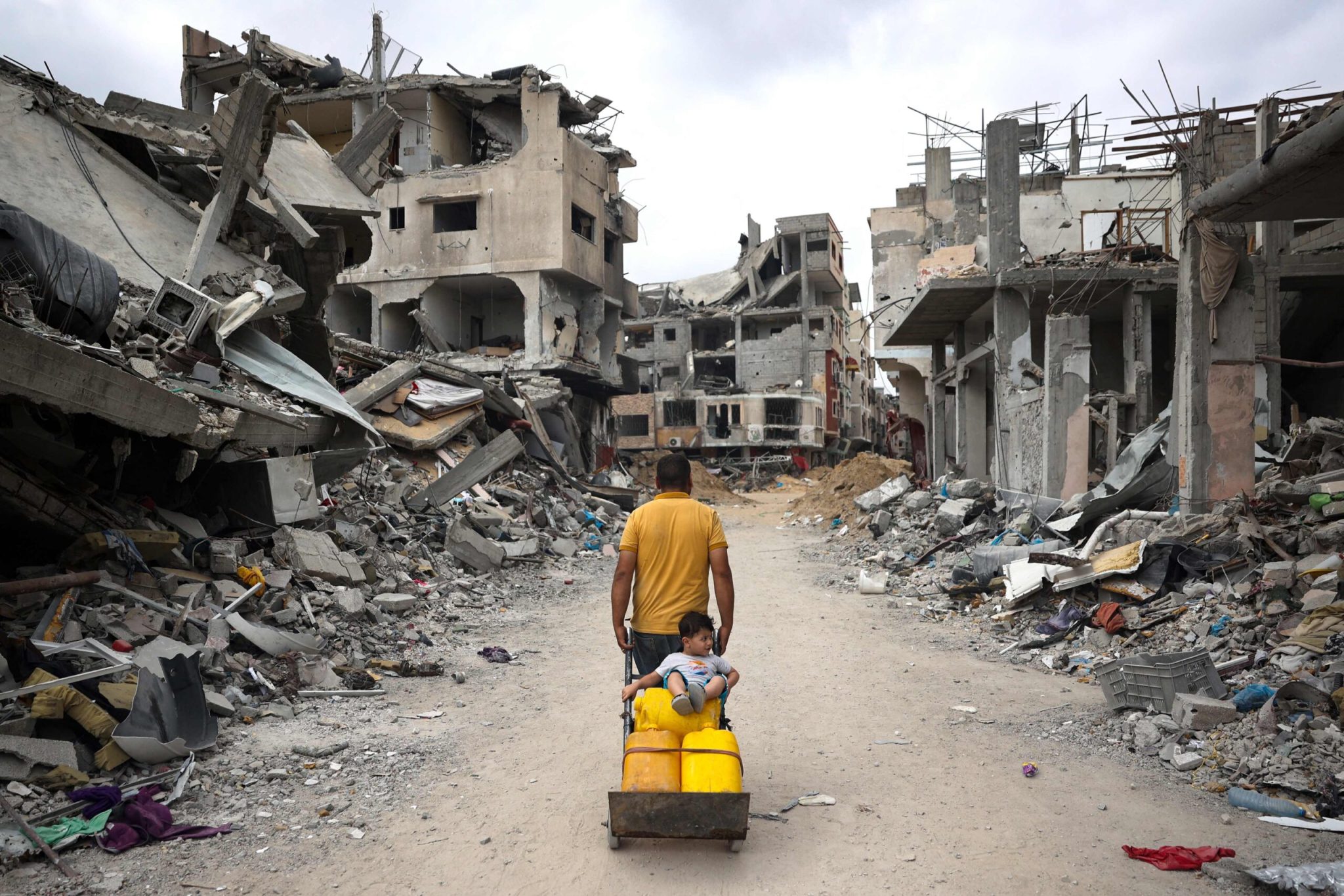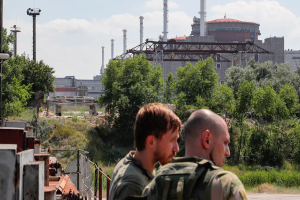The month of October further compounded Ukraine’s challenges. While Russia benefitted from robust military support from its authoritarian allies, the aid from Ukraine’s democratic allies was markedly less forthcoming. Hindered by the structural constraints within Europe’s defence industry and political landscape, coupled with partisan bickering within the American Congress, the provision of critical artillery shells was significantly delayed. In April 2024, President Biden authorised a substantial security support package totalling $61 billion in military aid to Ukraine. Nevertheless, the delays, among other factors, led to the fall of Avdiivka — a fortress town in Donetsk Oblast which had repelled assaults from both regular and irregular Russian forces since 2014.
How the War on Ukraine Impacted Gaza (and Vice-Versa)
On 7 October 2023, the armed wing of Hamas executed an unprecedented, multi-domain, combined-arms offensive manoeuvre followed by a series of atrocities — to include mass-murder terrorism, hostage-taking, and kidnapping of children — in Israel’s “Gaza Envelope.” Parts of the operation mimicked several techniques and tactics seen in Ukraine, ranging from unmanned quadcopters dropping improvised explosive devices (IEDs) on fortifications and sentry positions to terrorism tactics committed by Russian regular and irregular forces.
The following ground war in Gaza has also shown light-infantry and artillery tactics in built-up areas seen in Ukraine. These include anti-armour, sniping, mortar-artillery, and rocket-artillery tactics, techniques, and procedures (TTPs). The attack was followed by a region-wide series of military confrontations in land, air, sea, space, electromagnetic, cyber and information/intelligence warfare.
The military operations in the Middle East have been intricately linked with Ukraine. Historically, both the Russian Federation and the Soviet Union envisioned a strategic continuum and an interdependent arc from the Baltics to the Mediterranean. Both states planned accordingly strategically, operationally, and sometimes even tactically. The Russian invasion of Crimea in January 2014 exhibited TTPs reminiscent of those employed by ISIS during its first takeover of Raqqa City in September 2013. The escalation ladder in the Donbas in 2015 was interconnected with Russian escalation/de-escalation (Putin’s peace initiative) in Syria during the same period. Iran has been a strong ally during its unprovoked aggression and illegal war on Ukraine.
Politically, Putin has allegedly described the operation as a “present” to a Hamas visiting delegation. The Gaza war didn’t just divert the media and diplomatic attention from the war on Ukraine but also delayed and diverted much-needed western artillery, air defence, and other categories of weapons and ammunitions from Ukraine to Israel. This is despite the huge difference in conventional and unconventional capabilities between Israel and Ukraine — on one end — and Hamas and Russia — on the other.
Considering these insights, four military observations from the Gaza-related conflicts may offer bases for developing lessons relevant to Ukraine: 1) the implementation of multi-domain, combined-arms offensive manoeuvres; 2) the management of horizontal escalation 3) the employment of flexible, multi-layered subterranean defence-in-depth; and 4) lobbying for expanding collective air defence beyond the Black Sea to encompass adjacent regions of Ukraine.
Multi-Domain, Combined Arms Offensive
Al-Qassam Brigades (QB), the military wing of Hamas, was deemed incapable of pulling off an operation of such magnitude as the October attack by the commanders of Israel’s military intelligence. QB and its nonstate allies (such as al-Quds Companies of the Palestinian Islamic Jihad and al-Aqsa Martyrs Battalions) followed a NATO-style conventional infantry breaching sequence (suppress, obscure, secure, reduce, and assault or SOSRA) to storm Israel’s “iron wall.”
QB managed to suppress and overwhelm Israeli air defences with unguided rocket artillery. Simultaneously, it blinded Israeli surveillance and reconnaissance assets to obscure their breach points and advance routes. This was done via a combination of armed commercial drones and snipers. QB could not, or would not, secure their breaching points in the Israeli barrier. Hence, other organisations and armed mobs followed QB’s units into Israel, multiplying the size of the attacking force.
The simultaneous, three-domain initial assault was conducted from the land by a QB regiment-sized light and motorised infantry formation; from the sea by two platoon-sized naval infantry formations; and via air by a company-sized formation of paragliders. The operation was a textbook breaching sequence—with few mistakes—executed mostly by irregular tools and uncommon equipment.

An Israeli soldier waits at a bus stop near the Israeli-Gaza border, April 28, 2024. Reuters/Scanpix
Subterranean, Flexible Defence-in-Depth
On 27 October 2023, the Israeli Defence Forces (IDF) launched a ground offensive in the Gaza Strip, following approximately three weeks of airstrikes. By December 2023, the IDF had deployed about 20 brigades — a force equivalent to roughly six divisions — within the Gaza Strip. For context, the IDF defeated a larger Egyptian army in about 35 hours with only three divisions in Sinai in June 1967.
Once again in 2023, well-prepared defensive lines — even by nonstate, besieged force — have proven their effectiveness. QB have prepared a multi-level network of tunnels across Gaza’s five provinces. In the urban environment, the preparations included interconnected buildings, urban-style foxholes, rocket-artillery holes in buildings’ walls, strong points, sniping positions, and interlocked fields of fire and kill zones for anti-armour and mortar teams.
These preparations have enabled QB and other organisations to execute a flexible defence-in-depth strategy, without which their survivability for over six months against the IDF would have been unlikely. Multi-level underground and overground tunnels have doubled or even tripled the size of Gaza’s urban battlespaces, thus allowing tactical retreats and advances.
Lines of communications between QB units and others were difficult to intercept, degrade, or destroy. The tunnels gave protection and mobility. It also enabled, and perhaps force-multiplied, their firepower due to the surprise element in ambushes where QB units would come out of unexpected positions in areas already cleared by the IDF.
Horizontal Escalation
Hamas has formed a series of tactical and strategic alliances with Iran and Iranian-supported nonstate forces in the region and beyond. The October attack was likely uncoordinated with Hamas’ allies, but the Iran-led alliance escalated horizontally.
Since 8 October 2023, exchanges between Hizbullah and its allies in South Lebanon and Israel have been rapidly escalating in intensity, scale, scope, and duration. As of mid-February 2024, the number of rocket attacks launched from South Lebanon consistently exceeded the numbers launched from Gaza. During March and April, Hizbullah’s barrages reached 100 rockets per day; not far from the June 2006 war average, which saw about 120 unguided rockets for 34 days.
South Lebanon wasn’t the only front heating up. A low-level insurgency in the West Bank has been steadily on the rise. Iran-backed Ansarullah — better known as the Houthis —have sustained long-range strikes against Israel, as well as various short-range strikes and even heliborne air assaults against commercial ships and naval assets in the Red Sea.
These attacks fall short of a direct war with Israel. They do, however, have a significant military impact in terms of propaganda (recruitment and mobilisation), strategic signalling and psychological warfare, attrition and saturation of air defence systems, and — in the case of Hizbullah — fixing entire Israeli divisions in the north.

Smoke rises following Israeli airstrikes in southern Gaza Strip city of Rafah, on May 7, 2024. ZUMA Press/Scanpix
Rocket Revolution and Air-Defence Evolution
Hizbullah’s land force remains concentrated in rocket and infantry artillery. However, a “revolution” is an appropriate term to describe what has happened to the organisation’s artillery arsenal between 2006 (its last full-scale war with Israel) and 2024.
In 2006, Hizbullah launched about 4 000 unguided rockets. Current estimates of Hizbullah’s arsenal are approximately 150 000 rockets and missiles. Those significantly vary in ranges, payloads/warhead sizes, guidance, etc. Longer-range rockets and missiles are a strategic problem for Israel. Even if Hizbullah’s ground forces were pushed back to the north of the Litani River, this would not end their threats. Hizbullah has an estimated 65 000 unguided rockets (up to 200 kilometres) and more than 5 000 guided missiles (over 200 kilometres). Hizbullah can still strike Tel Aviv from the north of the Litani River, albeit not with the same intensity.
Iran, Hizbullah’s main sponsor, launched its first direct attack on Israel on 13 April 2024. It featured about 170 one-way loitering munitions (commonly known as “suicide drones”), 20 standoff cruise missiles and 120 mid-range ballistic missiles. Iran did not (or could not) attempt to radar-jam, suppress, or destroy Israel’s air defences, interdict Israeli warplanes or even sustain precision. Still, Nevatim Airbase had cratered runways and Ramon Airbase was hit with several ballistic missiles. Both, though momentarily silenced, resumed their pulse by day’s end. Israeli air defences, helped by an unprecedented coalition of regional and international allies, reasserted their combat effectiveness.
Israel did hit back, but with a very different strike package: stealthy, precise, succinct, and with a controlled impact. At least three missiles hit an Iranian S-300 battery in Isfahan. The strike damaged or destroyed a radar system — a part of the battery that protects the Natanz nuclear facility. The message was clear: Iran’s nuclear facilities are reachable by Israeli air-launched fires, and neither Iran nor its allies can air-defend against them.
Both the Iranian and the Israeli operations were combined-arms, three-domain operations (air-launched, land/ground-launched and exo-atmospherically space-intercepted). The strikes remain in the category of “strategic signalling” as opposed to “military effectiveness.” They are still far from any form of conventional attrition.
Implications for Ukraine
The intense and evolving military dynamics in the Middle East may hold insights for Ukraine, as it fights back a Russian aggression. The implications can be profound, not only in terms of tactical adaptations but also in terms of strategic coalition-building and the further enhancement of Ukraine’s defensive and offensive capabilities.
The October attack was a low-cost, multi-domain, textbook-like breaching operation against complex, technologically advanced defences and far superior forces. The strategic value of the horizontal escalation by nonstate allies remains contested. But Ukraine is defensively doing so against Russian aggression on its territories as well as in Africa. The effective use of subterranean tactics demonstrated, once again, the values of defence-in-depth preparations, through the development of fortifications, underground facilities, and tunnel networks — many of which already exist in Ukraine. Subterranean enablers were used by Ukraine, most notably in Mariupol. However, it was also used by the Russian forces, most recently during the attack on Avdiivka.
Finally, to protect Ukraine’s skies and civilians, particularly in its southern and western regions near the Black Sea, it is imperative to extend the collective air defence missions currently undertaken by some of the NATO allies in the Black Sea. This expansion would specifically help against localised attacks by Russian cruise and ballistic missiles, as well as loitering munitions. Such measures are crucial in protecting the airspace of an ally, as shown in the case of Israel’s collective air defence. In the case of Ukraine, it aligns with previous security assurances provided by the US and the UK, including in the Budapest Memorandum to which Russia is a signatory. Collective air defence may represent a commitment to upholding international agreements, reinforcing the security framework designed to maintain stability and deterrence, and protecting the skies the NATO’s eastern front.










